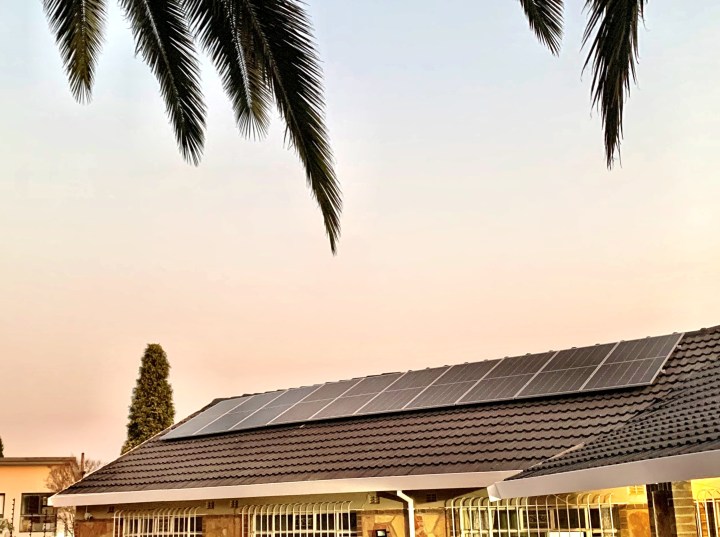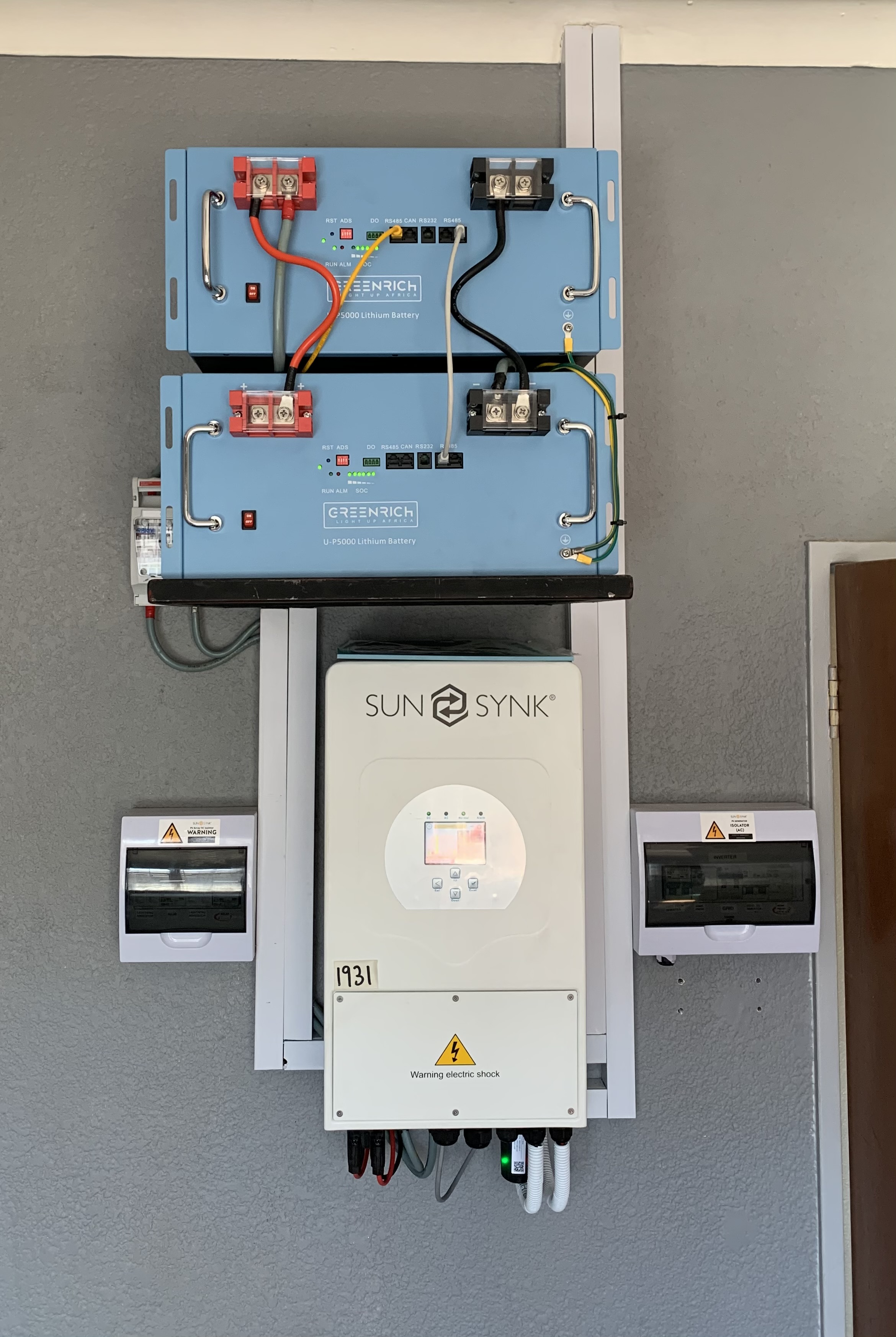RENEWABLE ENERGY
Residential solar power systems: Soaking up the sun is rewarding, but it isn’t all plain sailing

Even after your solar power system is installed, getting everyone in the house to use less electricity isn’t as simple a task as you might think.
When the stroppy septuagenarian accuses you of trying to kill her after she’s endured the ignominy of two lukewarm showers in the middle of winter in Joburg, the correct replies are not “if that was my intention, I’m sure I could find a quicker way to kill you, mom”, or “have you heard of this crazy Finn, Wim Hof?”
Going solar isn’t all it’s cracked up to be, particularly if the people living with you don’t understand the experimental nature of installing a grid-tied solar power system.
Do the research
When I started researching solar power systems, I found the whole process daunting. We’re being asked to spend as much money as we would on a car, yet there is little in the way of regulatory authorities or a sunny ombudsperson ensuring we’re not all buying the equivalent of skorokoros with a Ferrari badge glued on to the bonnet.
So, I’m going to explain what I did and why, in the hope that it will help you make a more informed decision about residential solar power systems. But I’m not an expert in this field and I, therefore, encourage you to spend several hours doing your own research, so you don’t end up being accused of trying to kill your mother because you forgot to put the geyser timer on.
Energy audit
We have a prepaid electricity system, so it was easy for me to calculate a daily average usage, and ours was about 60kWh per day. Installing a solar power system just to get you through rolling blackouts/load shedding isn’t going to work if you don’t know how much electricity you’re using every day.
While doing your own energy audit, you will soon realise that any appliance with a heating element is an energy-sapping fiend. For example, if you have a 5kW inverter and you use a toaster (about 1kW), an electric kettle (1.6kW) and a microwave oven (1.4kW) while the dishwasher (2kW) is on during a blackout, you’ve overloaded the inverter.
What’s worse is that some inverters, such as certain models of Growatt, have warranties that are voided in the event of the inverter being overloaded.
So, if you don’t take the time to understand how much electricity your appliances use, you might overload your inverter and void the warranty a few days after it’s installed.
Get at least three quotes
I sourced quotes from three companies, asking each installer the same 15 questions.
Don’t blindly trust what the solar power installers are telling you, because suddenly everyone giving you a quote will have been in the solar business since Ra was a wee lad.
Compare their answers with your own research and speak to people who already have solar power systems. You’re going to be spending anything from R100,000 to R500,000, so take your time to choose the right installer who gives you the best advice for your situation.
One of our potential installers made the lofty claim that with a 3kW inverter and a 3kW battery, he would be saving us more than 70% of our current energy usage. That sounded too good to be true – and it was, because he didn’t tell me that his idea of saving us 70% meant that our geysers, dishwasher and washing machine wouldn’t be attached to the inverter.
Many people are choosing to exclude geysers from their solar power systems, which means the geysers will only ever draw power from Eskom/the power grid, but there are pros and cons to this choice. If you do this, you will ensure the geyser never drains your battery, but how will you heat water in the event of an extended power outage?
We chose to install geyser timers with a smartphone app so that we could control the geysers, but there was that one morning when grid power hadn’t come back on as scheduled after load shedding and the geyser nearly drained the battery.

The batteries and inverter take up a fair amount of space. (Photo: Sukasha Singh)
Do not go off the grid
We’re all furious about how State Capture has crippled Eskom, but going for an off-grid setup isn’t feasible. There are instances when the power grid comes in handy, such as a week of rainy weather when your solar panels won’t generate more than 30% of their normal output.
And if something goes wrong (and something always goes wrong) with any components in your system and the inverter is not supplying power to your home, you’ll be glad that Eskom is still an option. A grid-tied/hybrid setup is the way to go for most residential solar power needs.
Listen to Daily Maverick’s new release of Eve of Destruction, a rousing anthem calling for action on the climate crisis.
Turning sunshine into money
Solar panels are heavy. Ours are 545W monocrystalline panels (polycrystalline ones don’t work efficiently when it’s cloudy), and each one weighs about 40kg. We currently have 10, but ours is an old house, so we had to start this whole process by replacing some of the beams in the roof to ensure the weight of the panels wouldn’t be a problem.
I spent a fair deal of time monitoring which parts of the roof had the most sun throughout the day, and I checked that the sunlight wasn’t being obstructed by any trees. During this process, I noticed that one of our neighbours had installed 15 super-duper glass solar panels. They’re beautiful, all-black and gleaming happily in the sun on a Tuscan-styled roof.
Once I got over my bout of panel envy, I asked our street WhatsApp group if they could recommend any solar power installers, and we ultimately went with a company that one of my neighbours recommended.
What I appreciated about Crown Technologies, other than the fact that they answered the never-ending list of questions I had, was that they wanted to decrease our overall electricity usage. They also had a finance option, which we didn’t use because we chose to extend our bond, and their main aim was for me to understand how to use the energy generated by the panels to “turn sunshine into money”.
What we did
We had two 200-litre geysers in the main house and another one in the cottage. We disconnected one of the geysers in the house and immediately saved 20kWh per day.
The two remaining geysers had 4kW elements, which we replaced with 2kW elements, and we installed timers to ensure the geysers aren’t on 24/7.
When you install a solar power system, you’ll be able to put certain appliances on the essential list (these appliances will draw power from the inverter) and others, like the electric stove, on the non-essential list (these appliances will only be powered by the grid and not by the inverter).
We chose to put everything except the electric stove on the essential list, including the pool pump. We did this so that we could run energy-intensive appliances (the washing machine, dishwasher, pool pump and geysers) during the sunny hours from 10am to 3pm to ensure that we’re making the most of our solar panels.
We started with seven panels, a 5kW Greenrich lithium battery (always choose lithium over lead or gel batteries) and a 5kW Sunsynk inverter. I chose the Sunsynk inverter because we can install up to 13 panels on this inverter and, if we want to expand the system, we’ll be able to install another Sunsynk inverter with additional panels that can be linked to the current inverter so that it all operates as one system.
After a few weeks, we added three more panels and, after four-hour blackouts, we added another 5kW battery because the current battery only just made it through the four hours.
During power cuts at night, we don’t use any big appliances and the geysers are off. The battery powers essentials such as the fridges, freezers, exterior LED lights, the Wi-Fi router, laptops and the electric fence.
When we have blackouts during the day, we run more appliances and have the geysers on because the 10 panels generate about 5.4kW of power during sunny daylight hours. With a 5kW inverter, you can have 10kW of batteries, but more than that might be too taxing on the inverter. We also added the second battery because we’re heading into the rainy season and four-hour blackouts sans maximum power coming from the panels on cloudy days means we’ll need the battery reserves.

The AC Load is what the house requires at any point in time and you can see when that power is coming from the panels, the batteries or the grid. (Photo: Sukasha Singh)
Things will go wrong
We installed the entire setup in the spare bedroom so that I can keep an eye on the system and also because the Wi-Fi extender is in the spare bedroom. The inverter needs to be close to the Wi-Fi router or an extender.
The Sunsynk app works well on my iPhone, and I can monitor our usage to see the amount of power being generated by the panels. I can even see how much power individual appliances are using when I put them on, one at a time. (The geyser timer app also works well on my phone – or not, if you ask my mother.)
I change the levels on the batteries often to ensure that they go down to 50% twice a day (when we’re not having power cuts) because this ensures the longevity of lithium batteries. When we’re experiencing rolling blackouts, I adjust the charge times to power the batteries up to 100% before the power goes out.
When we installed the additional three solar panels, the inverter suddenly started to feed power back to the grid, which it obviously shouldn’t do.
This problem drove the Crown technician, Marc Taljaard, and me quite mad because this was a completely new system and it should have been functioning perfectly. Taljaard checked and rechecked that every component was properly installed. Then he removed the inverter and took it back to Sunsynk, who were kind enough to check the unit almost immediately because it was brand new.
SA government aims to drastically cut red tape on solar energy projects
Sunsynk didn’t find any fault with the inverter, but when Taljaard reinstalled it, it was still sending power to the grid. Eventually, he decided to change the Current Transformer unit, which turned out to be faulty because as soon as he installed a new one, everything was peachy again.
This experience made me glad that I went with Crown Technologies because things will go wrong with your installation and, when they do, you’ll be happy that you took the time to interrogate the installers properly and to choose one that’s committed to getting things right.

At 11.35am, the panels are generating nearly 5kW to charge the batteries and power the house. (Photo: Sukasha Singh)
Pay as you grow
We didn’t have half a million bucks to spend on our solar power system, so we opted to start small and “pay as you grow”, that is, to add components as we could afford to do so. However, if you don’t need to stick to a budget, then you can go with a 30kW system off the bat and you won’t have to give the toaster and electric kettle the boot.
Our initial installation cost was R132,000, and the additional panels and battery have taken that figure up to R181,000. That’s a lot of money, and it’s also why the entire system is covered by our home insurer, Absa.
With all the additional adjustments we’ve made – using LED lights, running major appliances during sunlight hours, and installing geyser timers and lower kilowatt elements – we now use just 20kWh of grid power per day. That’s a saving of about 66% (roughly R4,000 per month) and our lights are on during blackouts. While none of this has been easy to achieve, it’s certainly worth it.
The system requires constant monitoring and tweaking, especially during Stage 6 load shedding, to ensure that none of the appliances drain the batteries, which need to be at 100% before the lights go out at night.
I’m still going to talk to the stroppy septuagenarian – ironically named Surya (the Hindu sun god) – about Wim Hof’s cold showers when she eventually calms down, not because this could result in us using even less electricity to heat the geysers, but because I really do believe that crazy Finn is on to something.

During load shedding at 11.51pm, the battery is providing 1kW for essential appliances. (Photo: Sukasha Singh)
A few questions you should ask a potential solar power installer:
- What happens if something goes wrong with the inverter, the battery or the panels?
- How long do repairs normally take for the various components?
- If something goes wrong, will you remove the faulty components and take them back to the manufacturer/importer?
- What are the warranties on the equipment and are these voided in the event of overloading?
- Is this inverter user-friendly and does it have a smartphone app?
- Will I have to do any firmware or software updates on the inverter? Are they easy to do?
- Are you going to supply a certificate of compliance when the job is done?
- What happens if lightning strikes the solar panels?
- How many comebacks have you had on this battery and inverter?
- How well do you know the importers of this equipment?
- How many more solar panels can I add to this setup?
- Can you show me pictures of a home where you recently did an installation? DM168
This story first appeared in our weekly Daily Maverick 168 newspaper, which is available countrywide for R25.






















 Become an Insider
Become an Insider
Great article, thanks. My solar system (8yrs old, just changed the gel batteries to lithium) has one major difference from Sukasha’s system. My geyser solar is heated using those glass tubes you see on roofs. This is the biggest saving of electricity you can make, heat your water using direct sunlight. The electric heating of the geyser is turned off normally, but can be switched on manually if needed.
Agree. A solar geyser is still cheaper than adding capacity to the PV / battery system. Use the grid as a backup for cloudy days. Being an independent system, even when the batteries go flat, you can still preserve the peace.
Good article.
I replaced my geysers with heat exchanging ones 303 liter tanks can stand outside and uses 500 Watt. I had the 1st one installed 12 years ago and besides 2 times service
runs perfectly fine . The insulation is supposed to hold the temperature loss at 1 C for 24 hours although I always take manufacturers claims with a pinch of salt .
My solar geyser was the best investment. It has paid for itself in <3 years. If it is cloudy we just switch Citipower on for an hour. I also converted to a gas stove- an 18kg gas bottle lasts for 3-4 months. However, we kept our electric oven.
What were the other 3 questions you asked, Sukasha?
That’s a pretty good and informative article for a non-expert. Thanks. There are however a few few errors and sources of confusion.
1. Batteries are rated in kWh, not kW.
2. You have about 5kW of PV panels. That’s about 25kWh of power generated per day. That’s the maximum saving you can make with your setup.
3. The 20kW saved from the switched off geyser simply means you used less hot water in your house and that’s the reason for the saving.
4. Trying to preserve battery life by allowing them to go to 50% twice a day makes no sense. Long term storage in the battery is most efficient at about 60% of maximum charge (called State of Charge, or SOC). But with daily battery cycling, and regular loadshedding sticking to this charge level is totally pointless. You should try to limit the lowest charge level to about 20% SOC for longest battery life, but most Li batteries can go down to 10% SOC without a problem.
@Jan Hough, you made the same error, calling kWh kW. haha.
In any case, I agree very much with your point 3 – most households have mixers set to the centre, which uses hot water at every use.
Very useful article, especially as I am considering solar myself. Will certainly use the questions suggested!
Thanks for a great article. We replaced our geysers with gas geysers. We only use gas when we shower and it is perfect. We waited for the geysers to fail and they were covered by our insurance. We use gas for showering and cooking. The heat exchange geysers sound interesting but I hate the idea of paying for something you are not using.
THANKS A MILLION
If you want to save energy and money, install solar water heating retrofits on your geysers. This will save 30% to 45% of your electricity bill.
If you have not done so, change all your lights to LEDS. Move from electric hob to gas. The payback on these changes will be less than 3 years.
Then, look at solar electric PV, not so much as a financial investment but a lifestyle investment. Payback is 9 to 19 years depending on how realistic you are on the calculations.
A load shedding ‘plug and play’ package will cost as little as R14,000. A plumbed in load shedding system (UPS) to the DB board, will result in seamless avoidance of load shedding will cost from R19,000 and up.
A small PV system will cost R80,000 and costs escalate from there to a large PV hybrid system of up to R500,000. Be aware that it is best to use Eskom for any appliance that generates heat, toaster, oven, heaters, dishwashers, tumble dryers, washing machines etc otherwise only use these appliances on a PV system in the middle of the day.
Unlike overseas, we do not have tax rebates or incentives and feeding back into the grid has limited financial benefit.
Consequently hybrid systems (with batteries) are very expensive here when compared to grid tied systems overseas (Australia, Texas, most of Europe).
If you want to save and avoid the stress of load shedding, go with solar water heating and an UPS.
If you have money to burn consider a bigger solar PV system.
Depending on your council, you are allowed to export surplus energy (when your solar is generating more than your loads and your batteries are full) and some will give you a bit of money for that. Unless you have a LOT of money, it is relatively simple to juggle your DB to only have essentials on battery. Avoid motor loads (pool pump, tumble drier, washing machine).
Thanks for the very informative article.
Heating your domestic water via heat pump or solar water heating makes a huge difference. The element is a big culprit. Besides the building regulations have for a while now indicated that 50% of new residences need to be heated by solar/heat pump.
I’m still two minded about the benefits of switching off of traditional geysers.
• To my knowledge photovoltaic systems for private homes were originally designed to be one step to replace fossile fuels by renewables. The intention was not to avoid regular blackouts caused by a failed sole supplier like Eskom. Therefore when first systems were introduced about 30 years ago in Europe, the subsidised refunds a home owner received for feeding excess power into the grid was much more than he had to pay for supplied energy. Meanwhile the investment in photovoltaic ist competitve out of itself against fossiles. The following points should be noted: Geysers and room heaters powered by a thermal solar system, heat pump or gas. Timer for washing machine and dishwasher. Battery buffer designed for a suitable average load over 24 hours in winter time. For the situation in SA in my opinion ist makes no difference if one decides for grid connection or stand alone. If the only motivation should be to avoid Eskom blackouts, a Diesel generator might bei the cheaper way. The costs of battery buffer to overbridge a continued “Stage 6 Load shedding” must be tanken into account. If you want to save the climate and avoid blackouts, I guess you have to invest in Solar and Diesel as well.
Great article Sukasha, thank you. As pointed out by many below, your quickest payback is a solar geyser (I have a Geyserwise timer and am super impressed with it) but it is still connected to the grid for those rainy days.
I have an almost identical system to yours, Sunsynk inverter works well and the app is great. Only 8 panels but also 2 x 5kWh batteries. I calculate payback at between 8 and 10 years.
I would urge anyone contemplating a system to do their homework as you (and I) did. There are so many cowboys out there who talk total BS (one guy told me that Lithium Ion batteries are rubbish).
It is not cheap, but the lack of power outage in just over a year is worth every penny, if only for my heart rate and temper.
Really nice article. We installed a solar system that is pretty similar and it’s one of the best things we ever did. One unexpected thing was that part of the saving was really understanding what electricity we were using and reducing this drastically. It does take some tweaking and sometimes we end up with cold water but we have had no fatalities from this. It would be very nice to feedback to the grid – it does seem sad that we have the capacity on very sunny days to do so but it gets wasted.
Thank you for a great article. I’m about to sign up and now have a raft of questions for the installer. I’m amazed that I had so many ‘quotes’ from people who didn’t even know what I need!